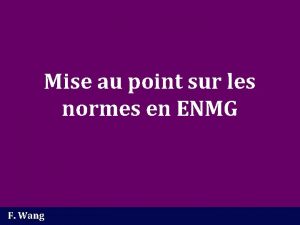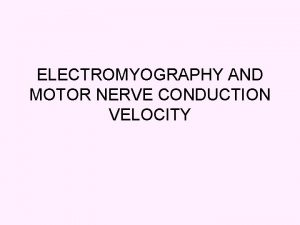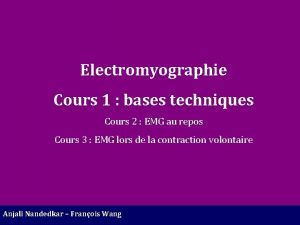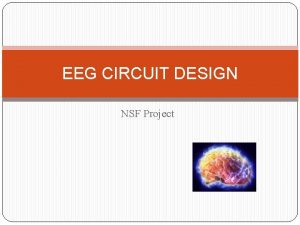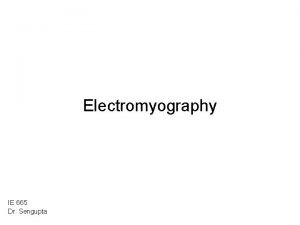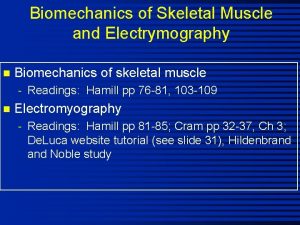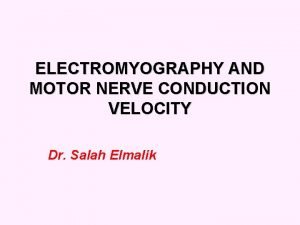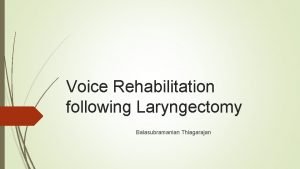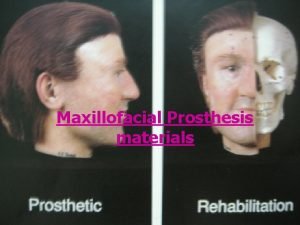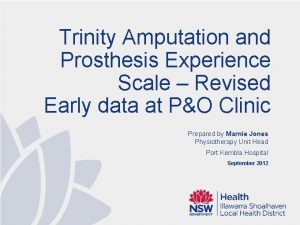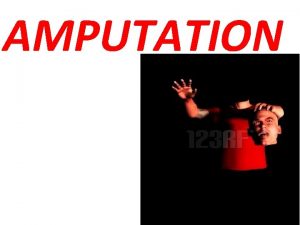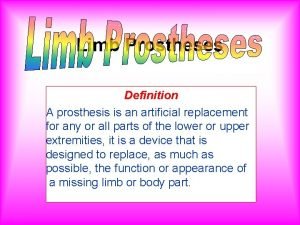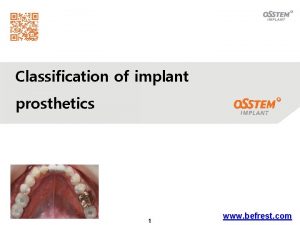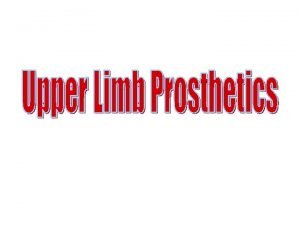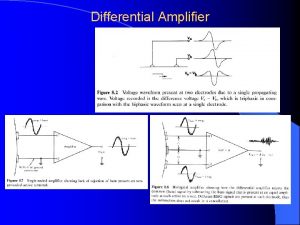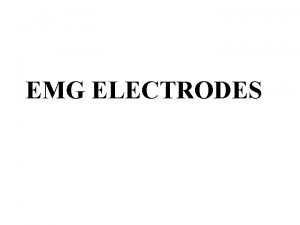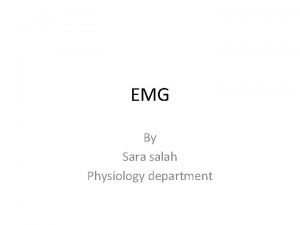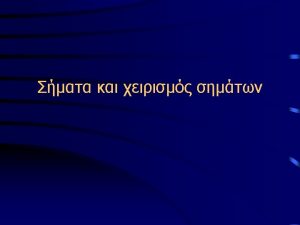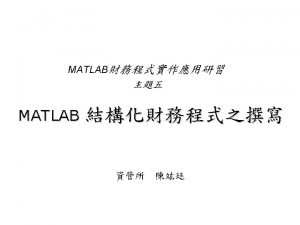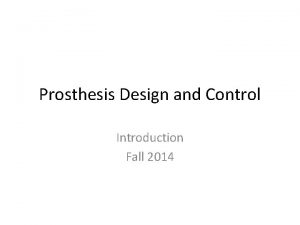USING EMG SIGNAL TO IMPROVE PROSTHESIS CONTROL Carolyn

























- Slides: 25

USING EMG SIGNAL TO IMPROVE PROSTHESIS CONTROL Carolyn Carr

INTRODUCTION Kuiken, T. et al, (2004) The use of targeted muscle reinnervation for improved myoelectric prothesis control in a bilateral shoulder disarticulation Amputee

INTRODUCTION Control of disarticulation shoulder prostheses Elbow, wrist, and hand Externally controlled One function at a time myoelectric signal or body powered Locks need to be done sequentially

INTRODUCTION Brachial plexus Function Upperlimb muscular innervation Cutaneious Amputation of the arm the “control information” for the arm is still in the Brachial Plexus Relocate the nerves Use the nerve muscle units for control

INTRODUCTION Difficulties: After transecting nerves do not reinnervate their own muscles consistently Controlling the independent nerve-muscle units Beneifts: Myoelectric control Motorneutrons transfer onto small amounts of muscle Hyper-reinnervate Improves muscle recovery Full muscle recovery possible

INTRODUCTION Purpose of this study is to use nerve transfers to improve control of the prosthesis using myoelectric control sites.

METHODS Subject 54 year old white male Bilateral shoulder disarticulation amputations Right side Body powered prothesis Voluntary opening split hook Four function unit 3 mechanical chin switches Elbow, wrist, and shoulder Left side to be replaced Externally powered prosthesis Use the muscles as a biological amplifier for independent signals

METHODS Reason for surgery Good shoulder motion Strong pectoralis muscle contraction No sign of brachial plexopathy Benefits Significant improvement in the left prosthesis If failed Still able to use what he was already using, touch pad control

METHODS Surgery Brachial Plexus identified Muscles in chest subdivided into individual units based on muscle innervations and vascularity Brachial plexus nerves mobilized down to the muscle segments

METHODS Surgery details: Pectoralis major was divided into three parts The clavicular head Lateral pactoral nerve, upper and lower segements. Sternal Head upper segments lower segments The pectoralis minor moved Moved laterally to the mid-axillary line Prevent EMG-Cross talk To Improve EMG signal, subcutaneious fat was surgically removed

METHODS Recovery Physical therapy The patient was told to open and close hand on daily basis 5 months active muscle contraction in different areas of the muscle

METHODS How to operate EMG signal held for 1 -2 seconds causes elbow lock Higher EMG signal to release Median area, controls open/close of hand Due to the two signals in Mid-pectoral, there were more options for wrist rotation A touch pad A strong contraction of open/close would switch the unit to pronation and supination a strong contraction to switch back, again,

METHODS Testing Box and Blocks test (Mathiowetx et al, 1985) 1 inch square blocks moved to another box, with an obstacle of a short wall in between box Modified, to test patient in a two minute time frame Clothes pins On a horizontal bar, rotation pin and move to high vertical bar Used three pins

METHODS EMG Programming, Three strongest signals used for control Signal under clavicle (large signal) musculocutaneious nerve Flexing elbow Mid-pectoral region, two independent signals Median Nerve Lateral, closing hand Medial opening hand

METHOD Inferior pectoral region Radial Nerve Extended elbow open hand extend the wrist Weak signal and difficult signal to isolate

RESULTS 3 out of 4 nerves were successful musculocutaneous nerve the median nerve the radial nerve Ulnar nerve to pectoralis minor nerve anastomosis No visible or EMG signal detected on the later pectoral region, where it was moved

RESULTS Box and Block Test Results Touch Pad Control Number of Blocks Myoelectric control Number of blocks Trial 1 5 10 Trial 2 5 14 Trial 3 7 18 Average 5. 7 14

RESULTS Clothes Pin Results Touch pad control Time (sec) Myoelectric control Time (sec) Trial 1 153 83 Trial 2 137 122 Trial 3 121 99 Average 137 101

DISCUSSION Three anatomical principles 1. Brachial plexus differentiates into the median, ulnar, musculocutaneous and radial nerves in mid-clavicle region 2. 3. Important for individual control The length of the distal brachial plexus and the terminal nerve were long enough to mobilize to the chest wall, without further grafting Pectoralis muscles was sub-divided into three parts If there where any overlap of the reinnervation, the EMG signals would have been comprimised.

DISCUSSION Musculocutaneous nerve: Successful Largest EMG signal, may be due to the proximity of the clavicle. Clavicle acted as an “electrical insulator” Median Nerve: Successful 2 different signals: Hand closing, hand opening Reinnervation of the abductor pollicis brevis Future studies should look into separating these out

DISCUSSION Radial Nerve: Weak Visibly and tangibly successful Not independent of other signals, and weak Electrocardiogram was large enough to interfere with the EMG signal Subcutaneous fat removed Ulnar nerve: Failed Reinnervation at the pactoralis minor When moving the pactoralis minor lateral, the blood supply was compromised Unexpected results Skin sensory Due to removal of subcutaneous fat

DISCUSSION Three independent signals Two degrees of freedom Faster control All test results showed compared to previous prosthetic the movement was more natural, and easier to control For the future Could apply to the shoulder movement Other levels of amputees

CONCLUSION Peripheral nerves were relocated to the pectoralis major muscle in a disarticulation patient Obtain simultaneous control, using EMG signal, for two degrees of freedom Sensory reinnervation was obtained in the upper portion of the chest

THANK YOU Questions?

REFERENCES Kuiken, T. , Dumanian, G. , Lipschutz, R. , Miller, L. , & Stubblefield, K. (2004). The use of targeted muscle reinnervation for improved myoelectric prosthesis control in a bilateral shoulder disarticulation amputee. Prosthetics And Orthotics International, 28(3), 245 -253. Retrieved from MEDLINE with Full Text database. Huang, H. , Zhol, P. , Guanglin, L, & Kuiken, T. (2009) Spatial Filtering Improves EMG Classification Accuracy Following Targeted Muscle Reinnervation. Biomedical Engineering, 37, 1849 -1857. doi: 10. 1007/s 10439 -009 -9737 -7
 Onde f emg
Onde f emg Emg instrumentation
Emg instrumentation How to calculate nerve conduction velocity
How to calculate nerve conduction velocity Pum emg
Pum emg Eeg amplifier circuit
Eeg amplifier circuit Cloud emg
Cloud emg Emg physiology
Emg physiology Applications of emg
Applications of emg Emg neurogenic vs myopathic
Emg neurogenic vs myopathic Neurografi emg
Neurografi emg Meditouch otolaryngology
Meditouch otolaryngology Maxillofacial prosthesis classification
Maxillofacial prosthesis classification Trinity amputation and prosthesis experience scales
Trinity amputation and prosthesis experience scales Syme's amputation
Syme's amputation Bugel prosthesis
Bugel prosthesis Prosthetic limbs meaning
Prosthetic limbs meaning Befrest
Befrest Function of prosthesis
Function of prosthesis Partial varia breast shapers
Partial varia breast shapers Dmaic model uitleg
Dmaic model uitleg Baseband signal and bandpass signal
Baseband signal and bandpass signal Baseband signal and bandpass signal
Baseband signal and bandpass signal Digital signal as a composite analog signal
Digital signal as a composite analog signal The product of two odd signals is
The product of two odd signals is Carolyn mendiola
Carolyn mendiola Synchronicity market timing
Synchronicity market timing
